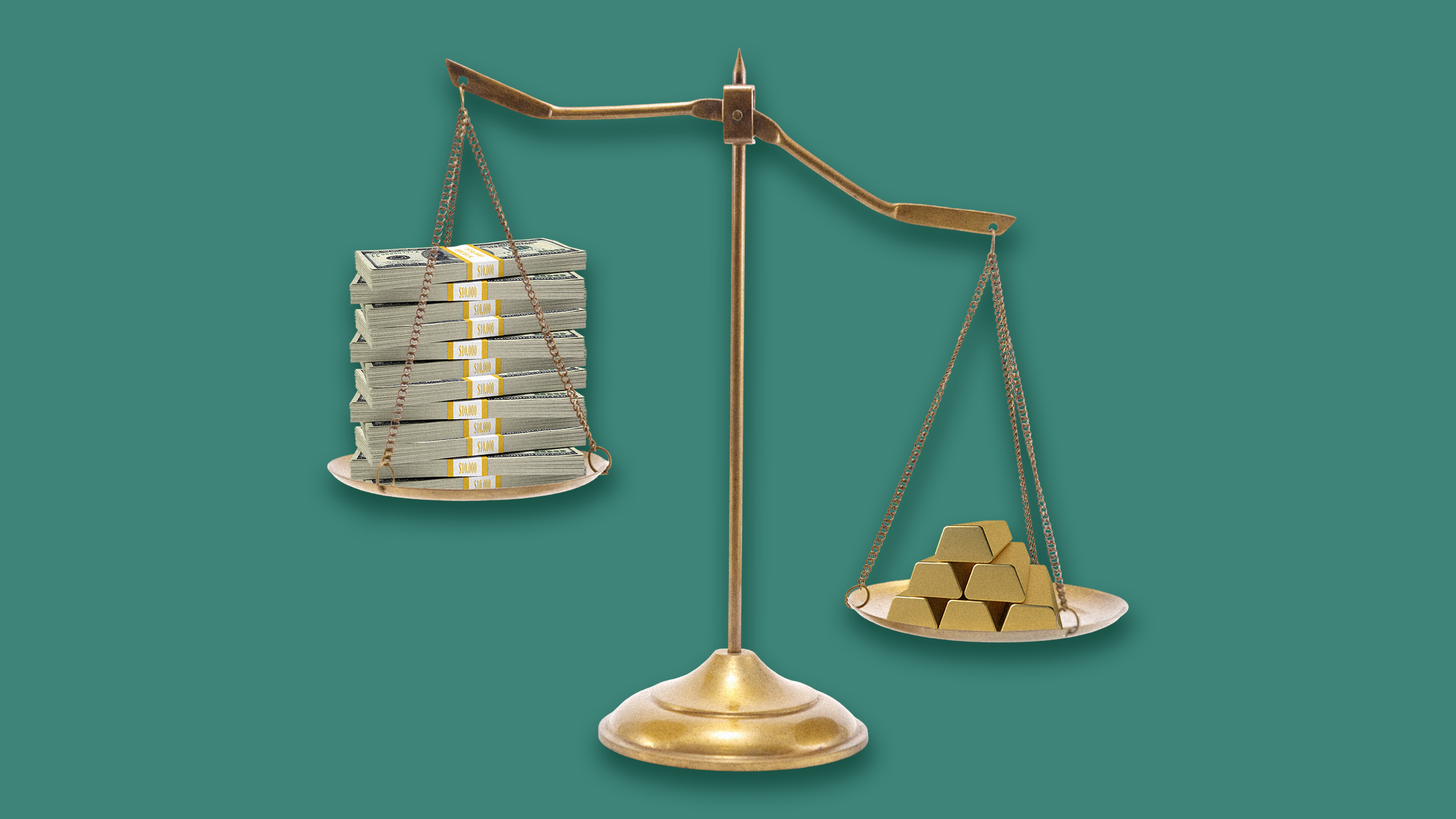Does Gold Still Make Sense After Hitting All-Time Highs?
Despite a pullback in May, the speed of the rally took even longtime gold watchers by surprise.

Sign up for market insights, wealth management practice essentials and industry updates.
Gold has even the most seasoned market watchers in awe.
Even after a pullback in May, the yellow metal gained around 25% so far this year, and hit an all-time, inflation-adjusted high of $3,500 an ounce in April. The rally enthralled Imaru Casanova, a portfolio manager at VanEck, who has covered the gold industry for 20 years. “I have to be honest, even for me, the rally this year was surprisingly fast,” she said. “We don’t see gold going from under $3,000 to $3,500 in a few months. That’s, sort of, almost violent.”
The impressive runup has spurred questions about whether gold is still a feasible portfolio insurance policy at these higher levels. Advisors who are looking at the precious metal need to decide its role in clients’ portfolios, whether it is a safe haven or a return driver, and that will determine whether current valuations make it too late to buy.
Golden Times
The rally’s velocity is at odds with gold’s historical track record. Since 1971, when the USgold standard was abandoned, the metal’s price in US dollars increased by an annualized 8% through 2024, according to industry group World Gold Council. Over that same time, the S&P 500’s annualized return, with dividends reinvested, was 10.7%. Gold’s return over the past 20 years is 9.3% and the S&P 500’s is 10.4%. Gold pays no dividends and has no yield, so its gain is price return.
Central bank buying has underpinned gold’s value in recent years, but the first quarter of 2025 saw a surge in investment demand from exchange-traded funds and similar products after a few years of little interest, which helps explain this year’s rally.
World Gold Council data showed ETF purchases were equal to 226.5 metric tons, nearly as much as the 243.7 tons central banks bought, and helped gold demand rise 16% year-over-year. Joseph Cavatoni, Americas senior market strategist for the World Gold Council, points out that except for gold used in jewelry, demand increased from investors, central banks and industrial users (usually in technology). “These use cases are all showing the right kinds of signs to give us confidence for what’s happening in the market today,” he said.
Cavatoni said despite gold’s high valuations, it remains a safe haven investment, noting systemic moments in the market are becoming more frequent and that gold holds its value and remains liquid when investors need cash.
VanEck’s Casanova said despite the rally, investor demand for gold is below its 2020 peak, so there is room for further upside if investors feel the need to own gold. Given the likely US macroeconomic policy uncertainty in the near- to medium-term, she said gold still has a role as an insurance policy in portfolios. She believes it’s the best reason to own gold, even though research shows that gold can enhance risk-adjusted returns and offers portfolio diversification.
“This year is a perfect example, you know, that when it needs to come to your rescue sort of thing, it does,” she said.
She doesn’t recommend tactical use. “I cannot say this enough. I’ve been covering the sector for 20 years, and I cannot time the sector,” she said.
A Golden Goose? The high prices have made some gold buyers cautious. Peter Thomas, chairman of offshore development at precious metals broker Ausecure and a physical gold dealer since the late 1970s, also wrestles with the idea of owning gold at these levels, and he cautions that volatility will likely be greater.
“When you have new heights and higher prices, it gets choppy. Swings will be wider,” he said.
Valuations should be a concern as well. Campbell Harvey, director of research at Research Affiliates and a professor at Duke University’s Fuqua School of Business, has studied gold’s historical price action. He said when inflation-adjusted, or “real,” gold prices are high, gold returns over the next 10 years are low.
Using consumer price index inflation measurements, it took gold 45 years to take out the inflation-adjusted all-time high of $850 an ounce set in January 1980. That occurred when the metal peaked at $3,500 in April.
How Three Advisors are Approaching Gold
Edison Byzyka, chief investment officer at Credent Wealth Management, said he is not looking to add gold to client portfolios.
“I think adding to gold right now is an indirect way of saying Treasury yields are going to go back up north of 5%. It’s a way of saying the U.S. dollar is on its way to its demise. It’s a way of saying that the global economy is going to be worse off than it was in the global financial crisis,” Byzyka said.
Gold as a hedge for stocks hasn’t always panned out, he adds. Using gold in lieu of bond exposure has worked this year, but he’s concerned about the portfolio impact if gold’s gains reverse.
“The downside a fixed-income investor would experience is something would be catastrophic to what they would expect in a bond portfolio,” he said.
John Koch, chief investment officer at iSectors, said the firm has offered clients different ways to own gold, either as part of a strategic precious metals allocation with gold, silver, platinum and palladium; within its broad liquid alternatives model as an inflation hedge; or in a quantitative dynamic model, allowing an algorithm to choose the allocation to gold as part of a multi-asset sector rotation.
His firm views gold as a portfolio diversifier because of its low correlation to other assets. In the strategic or inflation hedge models, the allocation can be between 5% to 10% as a long-term holding, although the quant model has been holding gold at a 30% allocation for the past two years.
Steve Conners, president of Conners Wealth Management, started adding gold to clients’ portfolios in fall 2024 and he thinks owning either gold ETFs or gold mining companies is still attractive at current prices.
Conners considers the pullback healthy. He said with the US dollar remaining unstable because of the uncertainty over the Trump administration’s tariffs and the potential impact on the economy, owning gold still makes sense. Plus gold continues to be an attractive hedge against future inflation, which he thinks is still a concern.
“I have no intentions of reducing or paring back; if anything, I’ll add,” he said. “OK, if [gold prices] can pull back a little bit more, I would prefer it.”











